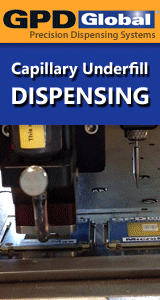Hi guys,
I really am at a loss to understand this one.
It would appear that there may be some reaction between the flux and the resist? Or maybe you have an OSP on the board that is reacting during soldering?
As a fast fix, maybe you should try an alternative flux that is rosin/resin free - I don't know if your present flux is of this type.
One other suggestion, is there any contamination coming from the fluxer if it spraying? Are you adding anything to the formulation for spraying?
OR MAYBE are you using any pre-preg or other silicone heat sink or buffer compound? If so, this could be "leaching" to create the effect you describe.
My other best recommendation is that you talk with Doug Pauls SIRGuru@aol.com or Terry Munsen Residuguru@aol.com who are Contamination Studies Laboratories.
Hope this helps | | | i am working with the noclean process and getting white residues on the bottomside of the board probably due to the | | | wave soldering flux.i am using a no-clean solder paste and a noclean wave solder flux.The boards passed the accelerated temperature and humidity tesing. Can i consider the residue as non-ionic. will it affect the assembly reliability?if so how?is there a standard in industry on the acceptable white residue for a no-clean process?please throw light on the problem | | | | | | Hi Dave, | that was a nice piece of information, indeed.But the assemblies which i am dealing with are not washed at all.all the incidences Graham sites are mostly when the no-clean /water-soluble fluxes are washed. are there any companies who go with the no-clean process(ont use any cleaning)and get away with the white residue? | | | Parag: White residues have varied sources, see link below, some "white residues" aren't even white. Some are ionic, some aren't. | | | | Other sources of whitish stuff on boards are: | | | | 1 Uncured Solder Mask: Sometimes uncured solder mask goes white when it partially cures curing wave soldering. Check the archives on checking for cured solder mask. Maybe Earl has some MEK "rat holed" away that he'll loan you. | | 2 Flux Types. No-clean fluxes can be either solvent (usually isopropanol) borne or water borne in the case of volatile organic compound (VOC) free no clean fluxes. Mixing flux types can develop white residues. Some no-clean fluxes "go white" in water. | | | | Contamination Testing. Check the archives on this. | | | | 1 Ionic contamination testing is like washing no-clean boards, as Graham Naisbitt says. | | 2 SIR testing will tell you if the board will be reliable, but will not tell you about the type and level of contaminants | | 3 Ion chromatography will tell you what is on your board and its level, but not if the board will be reliable | | | | Hit it Graham | | | | Good luck in your investigation | | | | Dave F | | | |
reply »
![]()
![]() i am working with the noclean process and getting white re...
- Jan 27, 1999
by
i am working with the noclean process and getting white re...
- Jan 27, 1999
by
![]()
![]() | i am working with the noclean process and getting white ...
- Jan 27, 1999
by
| i am working with the noclean process and getting white ...
- Jan 27, 1999
by
![]()
![]() | | i am working with the noclean process and getting whit...
- Jan 27, 1999
by
| | i am working with the noclean process and getting whit...
- Jan 27, 1999
by
![]()
![]() | i am working with the noclean process and getting white ...
- Jan 28, 1999
by
| i am working with the noclean process and getting white ...
- Jan 28, 1999
by
![]()
![]() | | i am working with the noclean process and getting whit...
- Jan 28, 1999
by
| | i am working with the noclean process and getting whit...
- Jan 28, 1999
by
![]()
![]() | | i am working with the noclean process and getting whit...
- Jan 28, 1999
by
| | i am working with the noclean process and getting whit...
- Jan 28, 1999
by
![]()
![]() Hi guys,
I really am at a loss to understand this one.
...
- Jan 29, 1999
by
Hi guys,
I really am at a loss to understand this one.
...
- Jan 29, 1999
by
![]()
![]() |I'm getting in a little late on this but my 2 cents is:
...
- Feb 10, 1999
by
|I'm getting in a little late on this but my 2 cents is:
...
- Feb 10, 1999
by







